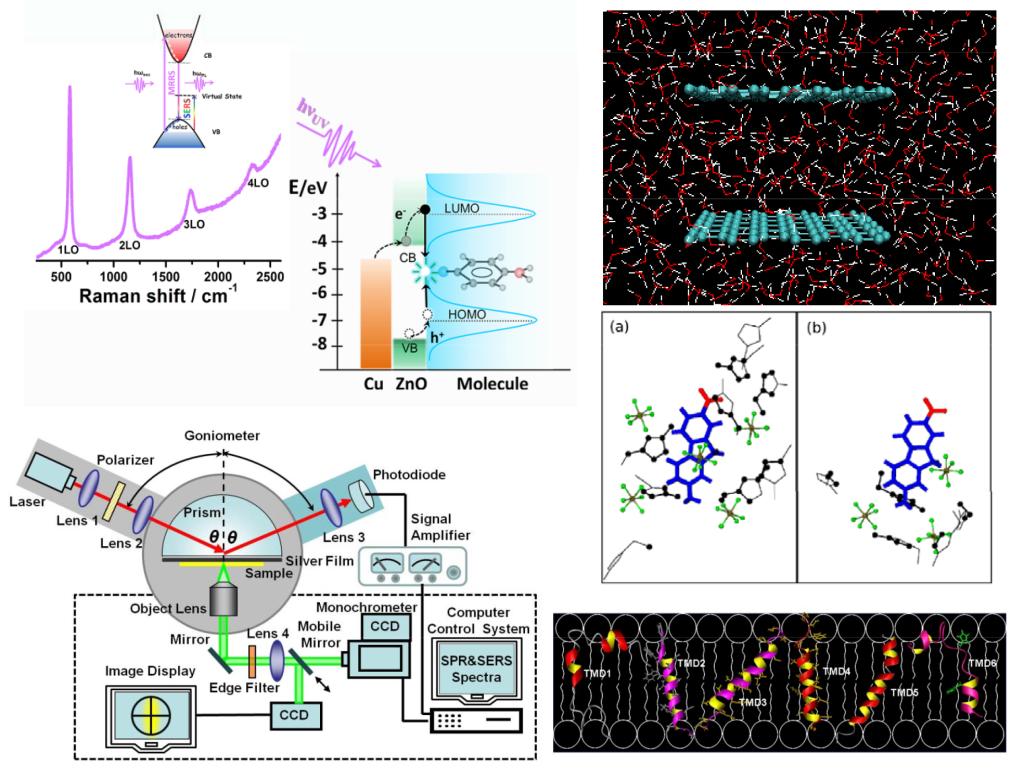
Structure is the basis of function. Supramolecular structures are built above the interaction between molecules. Methods and techniques for studies on the structure of assemblies and the assembled process are most required. So, the perspective of Department of Supramolecular Spectroscopy and Theoretics is to build, develop, modify and employ the theories and methods to answer questions in supramolecular science. Main research interests involve: (1) Exploring new theoretical, spectroscopic and experimental methods for supramolecular systems. We developed many high-sensitive techniques, e.g. surface-enhanced Raman scattering spectroscopy (SERS), to investigate the physical chemical subjects about surface and interface and the mechanism of SERS on metals or semiconductors. (2) To design, develop and modify spectroscopic methods and instruments for learning the interaction between molecules. For example, SPR-SERS co-detection and many new SERS approaches for protein analysis and detection, etc. (3) Utilizing spectroscopic techniques and theories to study the structural basis of protein function and dysfunction, including structures of membrane proteins and self-assemblies of amyloid peptides. (4) To build and develop theoretical models, calculation methods and simulation engines for the studies on the synergy effect dominated formation processes, properties and functions in supramolecular systems.
The current research of Prof. Bing Zhao’s group concentrates on surface-enhanced Raman scattering (SERS) and its applications, including metal and semiconductor-enhanced Raman scattering(A) and SERS-based applications in biology(B), food and environmental safety evaluation(C).To develop new SERS-active substrates and deeply understand the charge-transfer mechanism, semiconductorand semiconductor-metal hybridnanomaterialsare fabricatedand investigatedwith respect to the SERS effect.By employing SERS-active substrates to biological systems, we develop SERS-based analytical methods for rapid detection of biomolecules with high sensitivity and selectivity. Another application of SERS that we are interested in isdevelopingnovel detection methods for toxic molecules, which may has great potential in practical applications for safety assessment of food, environment, and commercial products.
The perspective of PERS group is to build, develop, modify and employ the theories and methods to answer questions in surface science.Main research contents involve: (1) To design, develop and modify spectroscopic methods and instruments for learning the interaction between molecules, e.g., SPR-SERS co-detection and SERS optical fiber sensor for chemical and bio analysis and detection. (2) Exploring new spectroscopic and experimental methods for self-assembly systems. We developed many high-sensitive techniques, e.g. waveguide-enhanced SERS, directional SERS, plasmonic nanoantennas, to investigate the physical chemical subjects about surface and interface and the mechanism of SERS on metals. (3) Utilizing spectroscopic techniques and theories to study on the relations of structure, function, and molecular interaction in the self-assembly systems and metal colloids. We applied many metal nanoparticle-assembled film for SERS, SEF, textile staining, and antibacteria etc.
Current research interests of Prof. Fei Li’s group include structures, assemblies and orientations of membrane proteins/peptides in membrane-mimic environments, interactions of membrane proteins/peptides with substrates and phospholipids, mechanisms of aggregation of amyloid polypeptides and methods to inhibit amyloid fibrillation, studied using spectroscopic and biophysical techniques.